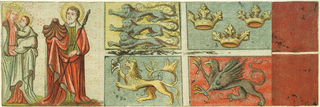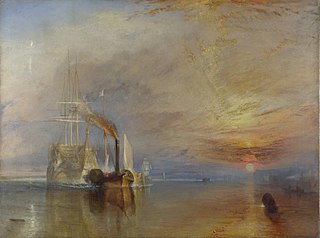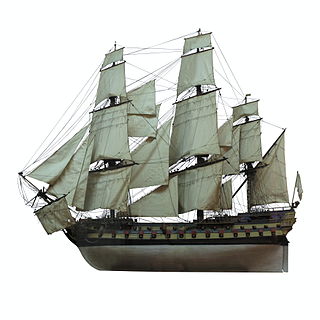
Jolly Roger is the traditional English name for the flags flown to identify a pirate ship preceding or during an attack, during the early 18th century.

A maritime flag is a flag designated for use on ships, boats, and other watercraft. Naval flags are considered important at sea and the rules and regulations for the flying of flags are strictly enforced. The flag flown is related to the country of registration: so much so that the word "flag" is often used symbolically as a metonym for "country of registration".

Striking the colors—meaning lowering the flag that signifies a ship's or garrison's allegiance—is a universally recognized indication of surrender, particularly for ships at sea. For a ship, surrender is dated from the time the ensign is struck.

A battle ensign is the name given to a large war ensign (flag) hoisted on a warship's mast just before going into battle.

HMS Shannon was a 38-gun Leda-class frigate of the Royal Navy. She was launched in 1806 and served in the Napoleonic Wars and the War of 1812. She won a noteworthy naval victory on 1 June 1813, during the latter conflict, when she captured the United States Navy frigate USS Chesapeake in a singularly bloody battle.

HMS Neptune was a 98-gun second-rate ship of the line of the Royal Navy. She served on a number of stations during the French Revolutionary and Napoleonic Wars and was present at the Battle of Trafalgar in 1805.

HMS Temeraire was a 98-gun second-rate ship of the line of the United Kingdom's Royal Navy. Launched in 1798, she served during the French Revolutionary and Napoleonic Wars, mostly on blockades or convoy escort duties. She fought only one fleet action, the Battle of Trafalgar, but became so well known for that action and her subsequent depictions in art and literature that she has been remembered as The Fighting Temeraire.

The naval Battle of Lagos took place between a British fleet commanded by Sir Edward Boscawen and a French fleet under Jean-François de La Clue-Sabran over two days in 1759 during the Seven Years' War. They fought south west of the Gulf of Cádiz on 18 August and to the east of the small Portuguese port of Lagos, after which the battle is named, on 19 August.

Achille was a Téméraire-class 74-gun French ship of the line built at Rochefort in 1803 after plans by Jacques-Noël Sané.

San Juan Nepomuceno was a Spanish ship of the line launched in 1765 from the royal shipyard in Guarnizo (Cantabria). Like many 18th century Spanish warships she was named after a saint. She was a solidly built ship of proven seaworthy qualities. Captured by the British Royal Navy during the Battle of Trafalgar, the ship was renamed first HMS Berwick, then HMS San Juan. The ship was discarded in 1816.

Often called bloody flags or the bloody red, pattern-free red flags were the traditional nautical symbol in European waters prior to the invention of flag signal codes to signify an intention to give battle and that ‘no quarter would be given’, indicating that surrender would not be accepted and all prisoners killed, but also vice versa, meaning that the one flying the flag would fight to the last man. Such flags were traditionally plain but examples with motifs also existed, such as skull and crossbones on some pirate examples.

Vengeur du Peuple was a 74-gun ship of the line of the French Navy. Funded by a don des vaisseaux donation from the chamber of commerce of Marseille, she was launched in 1762 as Marseillois.

HMS Canopus was an 84-gun third rate ship of the line of the British Royal Navy. She had previously served with the French Navy as the Tonnant-classFranklin, but was captured after less than a year in service by the British fleet under Rear Admiral Horatio Nelson at the Battle of the Nile in 1798. Having served the French for less than six months from her completion in March 1798 to her capture in August 1798, she eventually served the British for 89 years.

USS Constitution vs HMS Guerriere was a battle between an American and British ship during the War of 1812, about 400 miles (640 km) southeast of Halifax, Nova Scotia. It took place on the 19th of August 1812, one month after the war's first engagement between British and American forces. Guerriere was proceeding to Halifax for a refit, having been detached from a squadron which had earlier failed to capture Constitution. When the two ships encountered each other on August 19th, Guerriere's Captain James Richard Dacres engaged, confident of victory against the larger, better-armed U.S. ship. The exchange of broadsides felled Guerriere's masts and reduced the ship to a sinking condition. Constitution's crew took the British sailors on board and set Guerriere on fire, then returned to Boston with news of the victory, which proved to be important for American morale.

HMS Malta was an 80-gun third rate ship of the line of the Royal Navy. She had previously served with the French Navy as the Tonnant-classGuillaume Tell, but was captured in the Mediterranean in 1800 by a British squadron enforcing the blockade of French-occupied Malta. Having served the French for less than four years from her completion in July 1796 to her capture in March 1800, she would eventually serve the British for forty years.

Neptuno was an 80-gun Neptuno-class ship of the line of the Spanish Navy. She was built in 1795 and took part in the French Revolutionary and Napoleonic Wars. She fought with the Franco-Spanish fleet in the battle of Trafalgar, and was wrecked in its aftermath.

The action of 30 May 1781 was a naval battle fought between two frigates of the Royal Navy and two of the Dutch Republic off the Barbary Coast. In the Netherlands it is known as the zeegevecht bij Kaap Sint-Marie. In a battle lasting more than two hours, Captain William Peere Williams-Freeman of the Flora, compelled Captain Pieter Melvill's Castor to strike her colours. Shortly after, Captain Gerardus Oorthuys of den Briel compelled Thomas Pakenham to strike Crescent. However, Flora came to Crescent's rescue before Oorthuys could board her, and forced him to retreat.

The Third Battle of Ushant or the action of 20–21 April 1782 was a naval battle fought during the American Revolutionary War, between a French naval fleet of three ships of the line protecting a convoy and two British Royal naval ships of the line off Ushant, a French island at the mouth of the English Channel off the northwesternmost point of France. This was the third battle that occurred in this region during the course of the war.

"With flying colours" is a popular idiom of the English language that is used to describe how well someone has completed a task. For example, a common use of the phrase is to refer to someone having passed a test or other examination "with flying colours," i.e. passed the test easily or with an exceptionally high score. The phrase originated in the Age of Discovery, when ships would return to port with their flags ("colours") either raised or lowered to signify that the ship had either been successful or defeated, with raised flags indicating success and lowered flags indicating defeat. Thus, "with flying colours" literally means that someone has completed a task, although idiomatically connotes particular success in that task.

The action of 27 February 1809 was a minor naval engagement during the French Revolutionary Wars. Two 44-gun frigates, Pénélope and Pauline, sortied from Toulon harbour to chase a British frigate, HMS Proserpine, which was conducting surveillance of French movements. First sneaking undetected and later trying to pass herself as a British frigate coming to relieve Proserpine, Pénélope approached within gun range before being identified. With the help of Pauline, she subdued Proserpine and forced her to surrender after a one-hour fight.




















